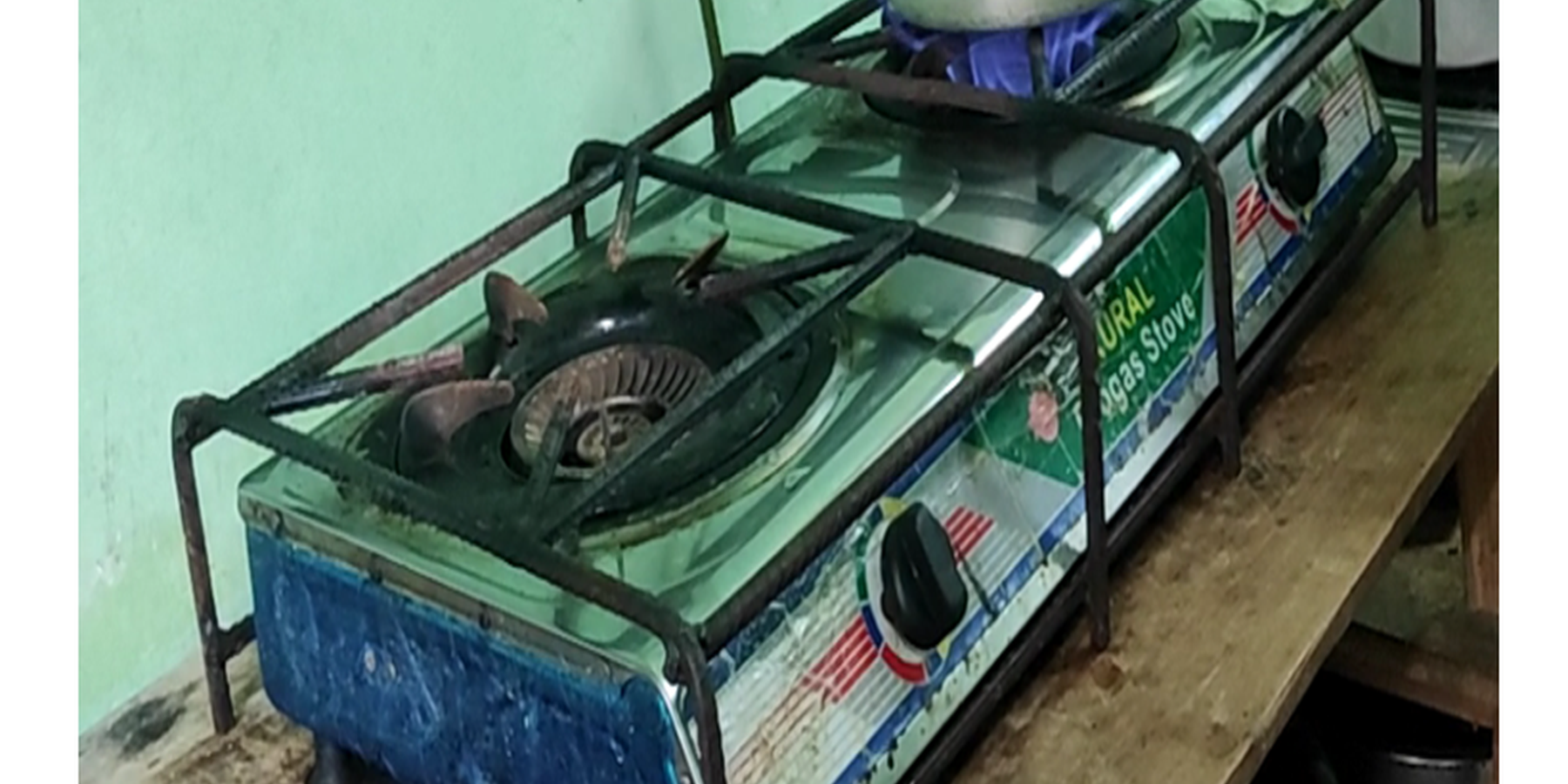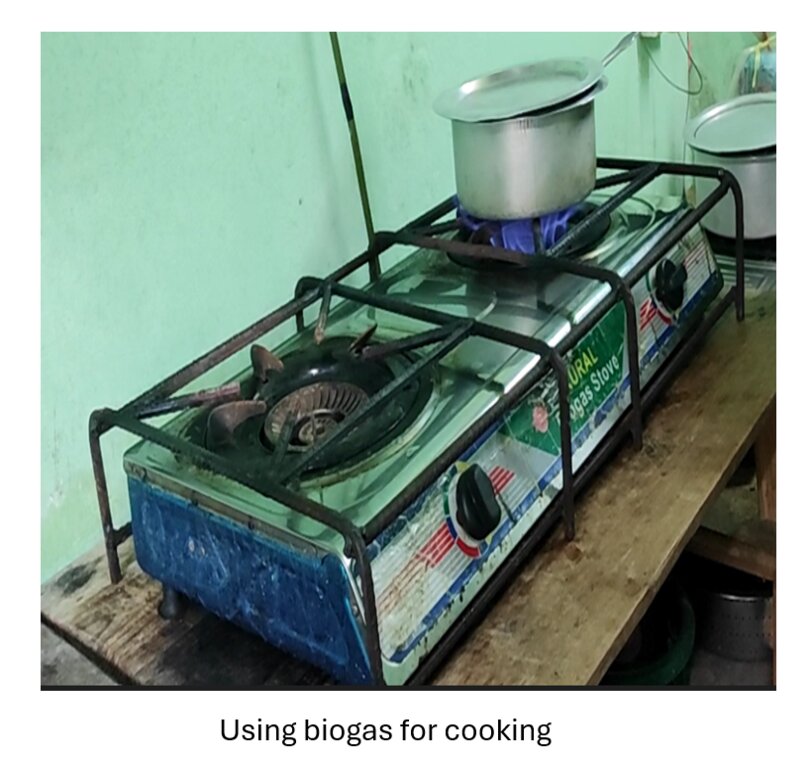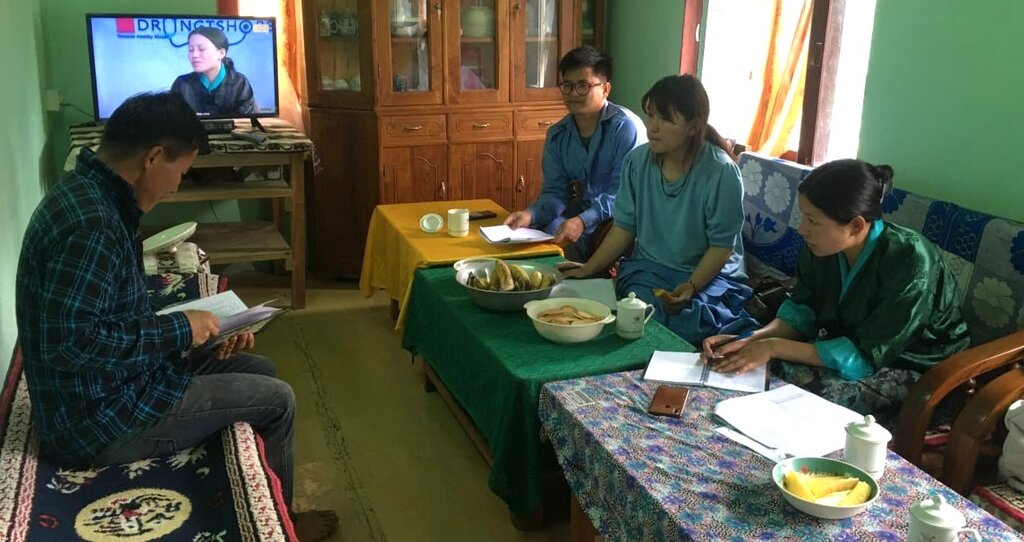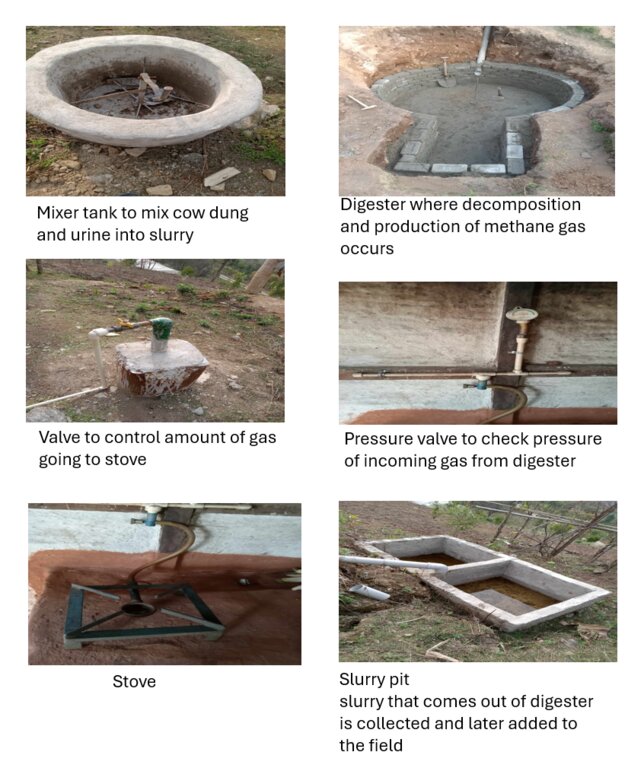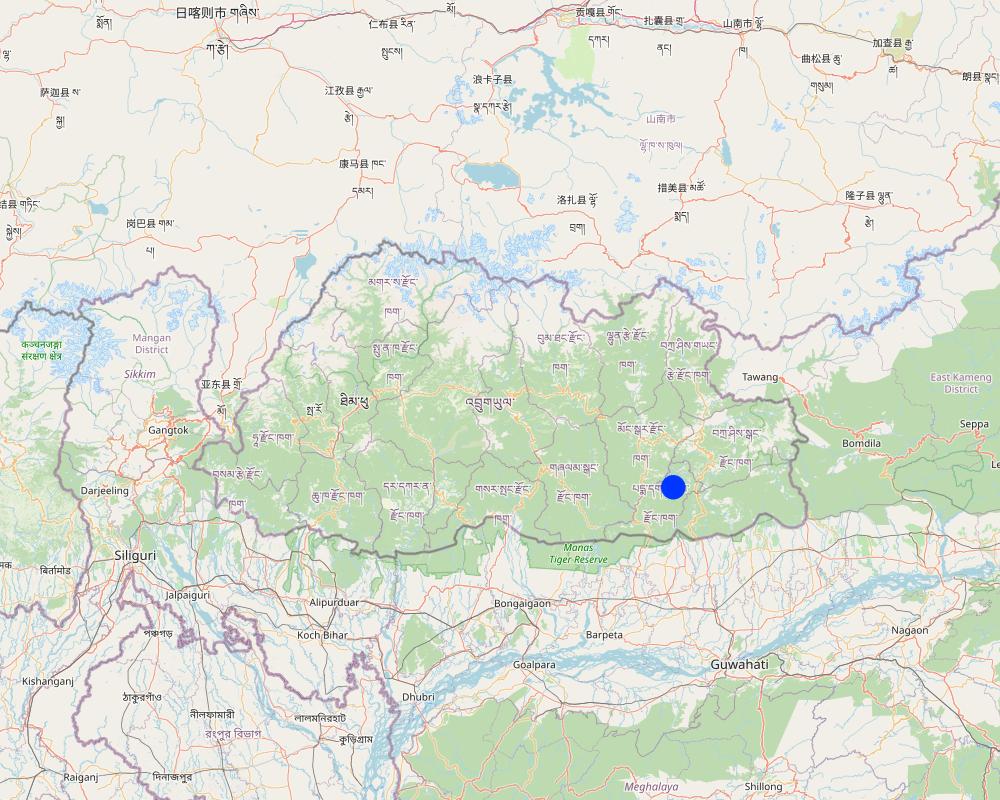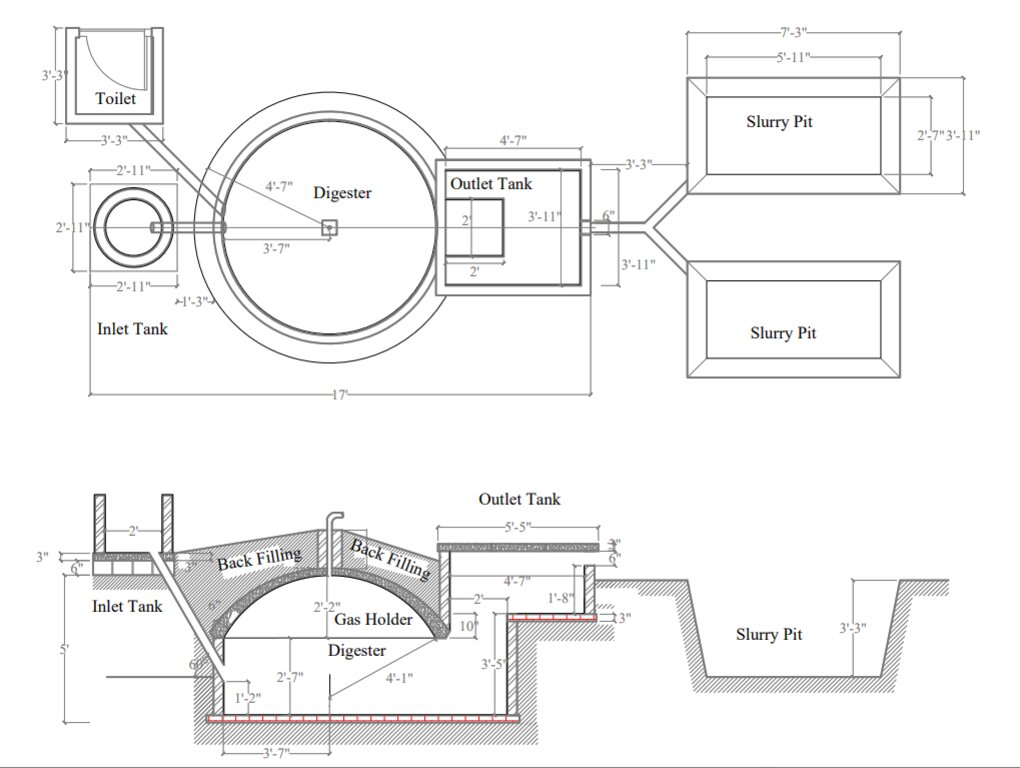Biogas plant [Bhoutan]
- Création :
- Mise à jour :
- Compilateur : ONGPO LEPCHA
- Rédacteur : Tashi Wangdi
- Examinateurs : Rima Mekdaschi Studer, William Critchley
Kayden meylung (སྐྱེས་ལྡན་མེ་རླུང་༑)
technologies_6865 - Bhoutan
Voir les sections
Développer tout Réduire tout1. Informations générales
1.2 Coordonnées des personnes-ressources et des institutions impliquées dans l'évaluation et la documentation de la Technologie
Personne(s)-ressource(s) clé(s)
exploitant des terres:
Tshojay Rangsem
Bhoutan
Nom du projet qui a facilité la documentation/ l'évaluation de la Technologie (si pertinent)
Strengthening national-level institutional and professional capacities of country Parties towards enhanced UNCCD monitoring and reporting – GEF 7 EA Umbrella II (GEF 7 UNCCD Enabling Activities_Umbrella II)Nom du ou des institutions qui ont facilité la documentation/ l'évaluation de la Technologie (si pertinent)
National Soil Services Centre, Department of Agriculture, Ministry of Agriculture & Livestock (NSSC) - Bhoutan1.3 Conditions relatives à l'utilisation par WOCAT des données documentées
Le compilateur et la(les) personne(s) ressource(s) acceptent les conditions relatives à l'utilisation par WOCAT des données documentées:
Oui
1.4 Déclaration sur la durabilité de la Technologie décrite
Est-ce que la Technologie décrite ici pose problème par rapport à la dégradation des terres, de telle sorte qu'elle ne peut pas être déclarée comme étant une technologie de gestion durable des terres?
Non
Commentaires:
The technology involves the use of cattle dung in the production of energy which is used for cooking. Stall feeding is practiced for easy collection of cattle dung. Therefore, land degradation due to the movement of cattle and overgrazing in the forest is reduced.
2. Description de la Technologie de GDT
2.1 Courte description de la Technologie
Définition de la Technologie:
Biogas is a renewable fuel generated through the anaerobic digestion of organic matter like food or animal waste, typically within a biogas plant. The biogas plant is adapted to household conditions and animal waste production. While this technology benefits small-scale farmers, challenges include the cost of establishment and the need for consistent waste input. Adoption has significantly reduced costs for users, lowered greenhouse gas emissions, and provided organic fertilizer, enhancing crop productivity and livestock health.
2.2 Description détaillée de la Technologie
Description:
Biogas is a renewable fuel produced through the anaerobic digestion of organic matter, such as food or animal waste. Typically, biogas is intentionally generated in an enclosed environment (a biogas plant) for household consumption. This plant is constructed near a livestock shed for easy collection of animal waste and in proximity to households, mainly used for cooking, heating, and as an alternative to commercial LPG gas.
The plant can be adjusted based on the amount of animal waste, making it viable for smallholder farmers with just a few cows. In most parts of the country, the technology is modified so that even a small amount of animal waste can produce some gas. The digestion chamber is made smaller in diameter and height to generate enough pressure for the gas to reach the stove through the pipe. Initially, the Biogas project started to promote clean and renewable energy for household cooking, reducing the consumption of firewood. Currently, there are more than 8000 biogas plants of different sizes - 4 m3, 6 m3, 8 m3, and 10 m3, and a few large-scale biogas greater than 50 m3 in large individual dairy farms and government livestock farms.
The major activities and inputs required to establish and maintain the technology include having ample space around the residential area for the plant's construction. Additionally, materials such as cement, sand, gravel, stone, iron rods, pipes, pressure gauges, and a stove are necessary. Human resources are needed for the construction of the plant, and land users should have livestock (cows, buffaloes, horses, etc.) that can provide dung/waste for gas generation.
There are numerous benefits and impacts of the technology, including its positive effects on rural communities, greenhouse gas emission reduction, maintaining carbon neutrality, and minimizing the use of imported LPG gas and chemical fertilizers. It also reduces electricity bills needed for operating electric heaters, saving time for land users who would otherwise collect firewood. The by-product (bio-slurry) from the digester is used as organic fertilizer, enhancing crop productivity and serving as a nutritious feed supplement for animals.
Land users both appreciate and have concerns about the technology. They acknowledge the cost reduction benefits, citing the significant savings compared to market-priced commercial LPG gas and reduced expenses on operating electric heaters. The technology has also provided them with additional time by eliminating the need to gather firewood. The bio-slurry, a by-product of the biodigester, serves as fertilizer to enhance crop production and contributes to livestock waste management, improving livestock health and production.
However, land users note that biogas plant establishment is expensive and may not be suitable for economically disadvantaged individuals. Some users experience challenges, such as the biodigester chamber failing to produce enough gas despite being constructed according to technical specifications. The daily requirement of adding animal waste to the input tank is perceived as tedious, and for land users with only one or two milking cows, supplying the required amount of animal waste for the biodigester chamber is often a problem.
2.3 Photos de la Technologie
2.5 Pays/ région/ lieux où la Technologie a été appliquée et qui sont couverts par cette évaluation
Pays:
Bhoutan
Région/ Etat/ Province:
Shumar Gewog (Block), Pemagatshel Dzongkhag (District)
Autres spécifications du lieu:
Darchung under Shumar Chiwog (Community)
Spécifiez la diffusion de la Technologie:
- appliquée en des points spécifiques ou concentrée sur une petite surface
Est-ce que les sites dans lesquels la Technologie est appliquée sont situés dans des zones protégées en permanence?
Non
Commentaires:
Biogas technology is used mainly for cooking and heating at the household level.
Map
×2.6 Date de mise en œuvre de la Technologie
Indiquez l'année de mise en œuvre:
2021
2.7 Introduction de la Technologie
Spécifiez comment la Technologie a été introduite: :
- par le biais de projets/ d'interventions extérieures
Commentaires (type de projet, etc.) :
Biogas technology was introduced as part of the Bhutan Biogas project under the then Department of Renewable Energy, Ministry of Economic Affairs and the Department of Livestock, Ministry of Agriculture and Livestock, Thimphu.
3. Classification de la Technologie de GDT
3.1 Principal(aux) objectif(s) de la Technologie
- améliorer la production
- atténuer le changement climatique et ses impacts
- créer un impact économique positif
- The main purpose as discussed by the land user was to reduce the cost and effort invested in getting LPG. Getting LPG was difficult becuase of the distance.
3.2 Type(s) actuel(s) d'utilisation des terres, là où la Technologie est appliquée
Les divers types d'utilisation des terres au sein du même unité de terrain: :
Oui
Précisez l'utilisation mixte des terres (cultures/ pâturages/ arbres):
- Agro-sylvo-pastoralisme

Terres cultivées
- Cultures annuelles
- Cultures pérennes (non ligneuses)
- Plantations d’arbres ou de buissons
- French bean, Potato, Onion, Chili, Cole crop (Cabbage, broccoli, Cauliflowers), Mustard green, etc.
- Avocado, Banana, Grapes, Mango, Papaya, Pomegranate, Pear
Nombre de période de croissance par an: :
- 3
Précisez:
Maize(fodder) is followed by vegetable like beans, which is again followed by Cole crops.
Est-ce que les cultures intercalaires sont pratiquées?
Non
Est-ce que la rotation des cultures est appliquée?
Oui
Si oui, veuillez préciser:
Maize(fodder) is followed by vegetable like beans, which is again followed by Cole crops (Cabbage).

Pâturages
- Land user allow six months of grazing in pasture land. Six months cattle are stall fed.
- Land user had eight cows which were all Jersey breed.
Est-ce que la gestion intégrée cultures-élevage est pratiquée?
Oui
Si oui, veuillez préciser:
Crop residue is used as feed, and cow dung as manure to improve soil fertility.
Produits et services:
- economic security, investment prestige
- manure as fertilizer/ energy production
- lait
Espèces:
bétail - laitier
Nombre:
8
3.3 Est-ce que l’utilisation des terres a changé en raison de la mise en œuvre de la Technologie ?
Est-ce que l’utilisation des terres a changé en raison de la mise en œuvre de la Technologie ?
- Non (Passez à la question 3.4)
3.4 Approvisionnement en eau
Approvisionnement en eau des terres sur lesquelles est appliquée la Technologie:
- mixte: pluvial-irrigué
Commentaires:
In rainy seasons irrigation supplies are disturbed frequently, In such cases land users depend on rainwater for animals and irrigation.
3.5 Groupe de GDT auquel appartient la Technologie
- gestion intégrée cultures-élevage
- gestion des déchets/ gestion des eaux usées
- technologies d'efficacité énergétique
3.6 Mesures de GDT constituant la Technologie

structures physiques
- S9: Abris pour plantes et animaux
- S10: Mesures d'économie d'énergie
3.7 Principaux types de dégradation des terres traités par la Technologie

dégradation physique des sols
- Pu: perte de la fonction de bio-production en raison d’autres activités
Commentaires:
Stall feeding can reduce land degradation by controlling movement of cow from one place to another. Dung is used for generation of fuel energy, and the waste produced after gas production, is applied to improve fertility of the land.
3.8 Prévention, réduction de la dégradation ou réhabilitation des terres dégradées
Spécifiez l'objectif de la Technologie au regard de la dégradation des terres:
- prévenir la dégradation des terres
- réduire la dégradation des terres
Commentaires:
Stall feeding reduces land degradation that can occur from the movement of cows from one place to another. Growing of fodder species like Napier grass, Guatemala grass, Pakchong (Super Napier), and Ruzi grass can prevent land degradation.
4. Spécifications techniques, activités, intrants et coûts de mise en œuvre
4.1 Dessin technique de la Technologie
Spécifications techniques (associées au dessin technique):
Technical design and specification of 4 cubic meter biogas plant capacity
Auteur:
Bhutan Biogas Project, Department of Livestock, Ministry of Agriculture & Livestock
4.2 Informations générales sur le calcul des intrants et des coûts
Spécifiez la manière dont les coûts et les intrants ont été calculés:
- par entité de la Technologie
Précisez l'unité:
inlet tank (mixing tank), inlet pipes, Digester, gas holder, manhole, outlet, main gas pipe turret, main gas valve, pipeline, water outlet, pressure gauge, gas tab, gas stove, gas lamp, slurry pit
Précisez les dimensions de l'unité de terrain (le cas échéant):
Dimensions of unit is given in technical diagram.
autre/ monnaie nationale (précisez):
Bhutanese Ngultrum
Indiquez le taux de change des USD en devise locale, le cas échéant (p.ex. 1 USD = 79.9 réal brésilien): 1 USD = :
82,73
Indiquez le coût salarial moyen de la main d'œuvre par jour:
Nu 350
4.3 Activités de mise en place/ d'établissement
| Activité | Calendrier des activités (saisonnier) | |
|---|---|---|
| 1. | Selection of construction site and layout of the plant | 1st March |
| 2. | Digging of pits | 15th April |
| 3. | construction of digester | May |
| 4. | construction of gas holder (dome) | May |
| 5. | Plastering of Digester and gas holder | May |
| 6. | construction of turret, manhole and outlet tank | May |
| 7. | Construction of Inlet Tank | June |
| 8. | Fitting pipelines and appliances | June |
| 9. | Construction of compost pit | June |
| 10. | Finishing and instruction to users | July |
Commentaires:
The land user could not mention the exact date for the initiation and completion of some activities. However, most activities were completed within May-June month.
4.4 Coûts et intrants nécessaires à la mise en place
| Spécifiez les intrants | Unité | Quantité | Coûts par unité | Coût total par intrant | % du coût supporté par les exploitants des terres | |
|---|---|---|---|---|---|---|
| Main d'œuvre | Labour | person-days | 18,0 | 350,0 | 6300,0 | |
| Main d'œuvre | Masion | person-days | 12,0 | 1000,0 | 12000,0 | |
| Equipements | Mixture machine | no | 1,0 | 1740,0 | 1740,0 | |
| Equipements | GI nozzle | no | 1,0 | 113,0 | 113,0 | |
| Matériel végétal | water draining pipe | no | 1,0 | 262,0 | 262,0 | |
| Matériel végétal | Main gas valve | no | 1,0 | 523,0 | 523,0 | |
| Matériel végétal | Paint brush | no | 1,0 | 85,0 | 85,0 | |
| Matériel végétal | Iron brush | no | 1,0 | 85,0 | 85,0 | |
| Matériel végétal | CPVC glue (50gm) | Jar | 1,0 | 390,0 | 390,0 | |
| Matériel végétal | Teflon tape | roll | 1,0 | 25,0 | 25,0 | |
| Matériel végétal | PVC pipe 4"10' (inlet) | no | 1,0 | 1050,0 | 1050,0 | |
| Matériaux de construction | Cement | Bag | 18,0 | 380,0 | 6840,0 | |
| Matériaux de construction | Bricks | No | 1000,0 | 11,0 | 11000,0 | |
| Matériaux de construction | Gravels | Truckload | 0,5 | 5000,0 | 2500,0 | |
| Matériaux de construction | Sand | Truckload | 0,25 | 6000,0 | 1500,0 | |
| Matériaux de construction | Arcrylic paint | litres | 3,0 | 350,0 | 1050,0 | |
| Matériaux de construction | Iron rod | kg | 10,0 | 70,0 | 700,0 | |
| Matériaux de construction | Dome pipe | No | 1,0 | 1170,0 | 1170,0 | |
| Autre | Stove | No | 1,0 | 1399,0 | 1399,0 | |
| Autre | CPVC Pipe (10') | No | 10,0 | 350,0 | 3500,0 | |
| Autre | Gas tap | No | 1,0 | 465,0 | 465,0 | |
| Autre | Pressure meter | No | 1,0 | 320,0 | 320,0 | |
| Autre | Elbow joint | No | 4,0 | 350,0 | 1400,0 | |
| Autre | T - union | No | 2,0 | 150,0 | 300,0 | |
| Coût total de mise en place de la Technologie | 54717,0 | |||||
| Coût total de mise en place de la Technologie en dollars américains (USD) | 661,39 | |||||
Si vous n'êtes pas en mesure de décomposer les coûts dans le tableau précédent, donnez une estimation du coût total de la mise en place de la Technologie:
50000,0
Si le coût n'est pas pris en charge à 100% par l'exploitant des terres, indiquez qui a financé le coût restant:
Raw material for construction of the plant was supported by the government.
Commentaires:
18 bags of cement, iron rods, pipes, a pressure gauge, and a stove were supported by government.
4.5 Activités d'entretien/ récurrentes
Commentaires:
It was a new plant so the land user did not mention anything on maintenance.
4.7 Facteurs les plus importants affectant les coûts
Décrivez les facteurs les plus importants affectant les coûts :
Raw materials, transportation cost, labour charges.
5. Environnement naturel et humain
5.1 Climat
Précipitations annuelles
- < 250 mm
- 251-500 mm
- 501-750 mm
- 751-1000 mm
- 1001-1500 mm
- 1501-2000 mm
- 2001-3000 mm
- 3001-4000 mm
- > 4000 mm
Zone agro-climatique
- subhumide
The study area is located in sub humid area
5.2 Topographie
Pentes moyennes:
- plat (0-2 %)
- faible (3-5%)
- modéré (6-10%)
- onduleux (11-15%)
- vallonné (16-30%)
- raide (31-60%)
- très raide (>60%)
Reliefs:
- plateaux/ plaines
- crêtes
- flancs/ pentes de montagne
- flancs/ pentes de colline
- piémonts/ glacis (bas de pente)
- fonds de vallée/bas-fonds
Zones altitudinales:
- 0-100 m
- 101-500 m
- 501-1000 m
- 1001-1500 m
- 1501-2000 m
- 2001-2500 m
- 2501-3000 m
- 3001-4000 m
- > 4000 m
Indiquez si la Technologie est spécifiquement appliquée dans des:
- non pertinent
5.3 Sols
Profondeur moyenne du sol:
- très superficiel (0-20 cm)
- superficiel (21-50 cm)
- modérément profond (51-80 cm)
- profond (81-120 cm)
- très profond (>120 cm)
Texture du sol (de la couche arable):
- grossier/ léger (sablonneux)
- fin/ lourd (argile)
Texture du sol (> 20 cm sous la surface):
- moyen (limoneux)
Matière organique de la couche arable:
- abondant (>3%)
5.4 Disponibilité et qualité de l'eau
Qualité de l’eau (non traitée):
eau potable
La qualité de l'eau fait référence à:
eaux de surface
La salinité de l'eau est-elle un problème? :
Non
La zone est-elle inondée?
Oui
Régularité:
épisodiquement
Commentaires et précisions supplémentaires sur la qualité et la quantité d'eau:
Recently, staff from the Ministry of Health tested the water quality, and the land user told that the water is good and drinkable.
5.5 Biodiversité
Diversité des espèces:
- élevé
Diversité des habitats:
- élevé
Commentaires et précisions supplémentaires sur la biodiversité:
Land users have planted almost all fruit trees, fooder species, annual crops, perennial vegetables like asparagus, etc., which indicated high species and habitat diversity.
5.6 Caractéristiques des exploitants des terres appliquant la Technologie
Sédentaire ou nomade:
- Sédentaire
Orientation du système de production:
- exploitation mixte (de subsistance/ commerciale)
Revenus hors exploitation:
- moins de 10% de tous les revenus
Niveau relatif de richesse:
- riche
Individus ou groupes:
- individu/ ménage
Niveau de mécanisation:
- travail manuel
Genre:
- hommes
Age des exploitants des terres:
- personnes d'âge moyen
Indiquez toute autre caractéristique pertinente des exploitants des terres:
The land user's age at the time of the interview was 45 years old.
5.7 Superficie moyenne des terres utilisées par les exploitants des terres appliquant la Technologie
- < 0,5 ha
- 0,5-1 ha
- 1-2 ha
- 2-5 ha
- 5-15 ha
- 15-50 ha
- 50-100 ha
- 100-500 ha
- 500-1 000 ha
- 1 000-10 000 ha
- > 10 000 ha
Cette superficie est-elle considérée comme de petite, moyenne ou grande dimension (en se référant au contexte local)?
- moyenne dimension
Commentaires:
According to the Land Act of Bhutan 2007. The maximum land ceiling per family is 25 acres, However, in Bhutan majority of land users are medium-scale i.e., less than 3 acres.
5.8 Propriété foncière, droits d’utilisation des terres et de l'eau
Propriété foncière:
- individu, avec titre de propriété
Droits d’utilisation des terres:
- individuel
Droits d’utilisation de l’eau:
- communautaire (organisé)
Est-ce que les droits d'utilisation des terres sont fondés sur un système juridique traditionnel?
Oui
5.9 Accès aux services et aux infrastructures
santé:
- pauvre
- modéré
- bonne
éducation:
- pauvre
- modéré
- bonne
assistance technique:
- pauvre
- modéré
- bonne
emploi (par ex. hors exploitation):
- pauvre
- modéré
- bonne
marchés:
- pauvre
- modéré
- bonne
énergie:
- pauvre
- modéré
- bonne
routes et transports:
- pauvre
- modéré
- bonne
eau potable et assainissement:
- pauvre
- modéré
- bonne
services financiers:
- pauvre
- modéré
- bonne
Commentaires:
The hospital is located 10 km away from Land users' places. Which makes it a little difficult during emergencies. The school is 2 Km away which is very near. There are also Gypsum Mining which provides off-farm activities to many land user in the locality. The land user is trained in making Biogas plants, this also provides him the opportunity to work off-farm. When it comes to energy, apart from energy to light the house, energy is required for cooking purposes. This energy was previously derived from LPG, however, after the Biogas plant land user is not having any difficulties with energy shortage. Land users have their own water source and the same water is used to feed Jersey cows. Land users also said that they get financial assistance from Bhutan Development Bank Limited.
6. Impacts et conclusions
6.1 Impacts sur site que la Technologie a montrés
Impacts socio-économiques
Production
production agricole
Commentaires/ spécifiez:
Land users didn't keep a record of the production, however, it was reported that crop production has improved.
qualité des cultures
Commentaires/ spécifiez:
land users reported that crops are healthier and green when manure prepared from cow dung/ biogas plants is applied on the land.
production fourragère
Commentaires/ spécifiez:
Land user is also members of milk cooperatives. He maintains different fodder species to have feed for his cows throughout the years. He said fodder production has increased over the years.
qualité des fourrages
Commentaires/ spécifiez:
Different species of fodder species like Napier, Ruzi, Guatemala, Super Napier, Banana, Rice straw, maize, and fooder tree species like Ficus auriculata, Ficus simicordata, etc., were observed.
production d'énergie
Quantité avant la GDT:
6 LPG cylinder per annum
Quantité après la GDT:
0
Commentaires/ spécifiez:
Each LPG cost around Nu. 1000. LPG is completely replaced by biogas technology.
Disponibilité et qualité de l'eau
qualité de l'eau potable
Commentaires/ spécifiez:
Water was not a problem from the beginning. However, with an improved breed of cow (jersey), water sanitation is also given more importance. Because water can bring diseases to family members and livestock.
Revenus et coûts
revenus agricoles
Commentaires/ spécifiez:
Land user don't have to buy LPG cylinders. He saves around 7000 in a year.
charge de travail
Commentaires/ spécifiez:
Workload has increased since the biogas plant was constructed. Every day the land user have to collect cow dung and add it to the plant. He also has to collect slurry and add to the land to improve fertility.
6.2 Impacts hors site que la Technologie a montrés
impact des gaz à effet de serre
Commentaires/ spécifiez:
Scope to conduct research to estimate GHG emission reduction from biogas technology
6.3 Exposition et sensibilité de la Technologie aux changements progressifs et aux évènements extrêmes/catastrophes liés au climat (telles que perçues par les exploitants des terres)
Changements climatiques progressifs
Changements climatiques progressifs
| Saison | Augmentation ou diminution | Comment la Technologie fait-elle face à cela? | |
|---|---|---|---|
| températures annuelles | augmente | bien | |
| températures saisonnières | été | augmente | bien |
| précipitations annuelles | augmente | bien | |
| précipitations saisonnières | été | augmente | bien |
6.4 Analyse coûts-bénéfices
Quels sont les bénéfices comparativement aux coûts de mise en place (du point de vue des exploitants des terres)?
Rentabilité à court terme:
très positive
Rentabilité à long terme:
très positive
Quels sont les bénéfices comparativement aux coûts d'entretien récurrents (du point de vue des exploitants des terres)?
Rentabilité à court terme:
très positive
Rentabilité à long terme:
très positive
Commentaires:
The investment cost is shared by the Government. Therefore, the land users felt the benefits are very positive.
6.5 Adoption de la Technologie
- 11-50%
Si disponible, quantifiez (nombre de ménages et/ou superficie couverte):
Only two households were interviewed, alothough, there are more than 300 households who have adopted biogas technology under study area (Shumar Gewog).
De tous ceux qui ont adopté la Technologie, combien d'entre eux l'ont fait spontanément, à savoir sans recevoir aucune incitation matérielle, ou aucune rémunération? :
- 0-10%
Commentaires:
The biogas technology was initiated and promoted by the Department of Livestock and Department of Renewable Energy in Bhutan on a cost-sharing basis.
6.6 Adaptation
La Technologie a-t-elle été récemment modifiée pour s'adapter à l'évolution des conditions?
Non
6.7 Points forts/ avantages/ possibilités de la Technologie
| Points forts/ avantages/ possibilités du point de vue de l'exploitant des terres |
|---|
| Land user need not buy LPG cylinders because the Biogas plant |
| No need to go to collect firewood |
| Points forts/ avantages/ possibilités du point de vue du compilateur ou d'une autre personne ressource clé |
|---|
| Efficient use of livestock (cow dung) for generation energy which is used for cooking. |
| The technology is not easily damaged by pests, temperature, rainfall, etc. |
6.8 Faiblesses/ inconvénients/ risques de la Technologie et moyens de les surmonter
| Faiblesses/ inconvénients/ risques du point de vue de l’exploitant des terres | Comment peuvent-ils être surmontés? |
|---|---|
| Cow dung has to be collected, and put into a mixing tank and mixing has to be done manually which is hectic. | |
| A huge amount of cow dung is required. |
| Faiblesses/ inconvénients/ risques du point de vue du compilateur ou d'une autre personne ressource clé | Comment peuvent-ils être surmontés? |
|---|---|
| Sometimes, despite good construction material, small calculations in biodigester and gas compartments can lead to a technical error, and this can inhibit gas production. In such cases, the biogas plant becomes nonfunctional. | Being extra careful with the design and consulting the biogas focal person to monitor the construction work. |
| Low temperature has a deleterious effect on methanogenesis and can cause decreased gas yields. So the technology may not work effectively in winter. | Maintaining the temperature by covering the tank with warm material. |
7. Références et liens
7.1 Méthodes/ sources d'information
- visites de terrain, enquêtes sur le terrain
1
- interviews/entretiens avec les exploitants des terres
1
- interviews/ entretiens avec les spécialistes/ experts de GDT
1
- compilation à partir de rapports et d'autres documents existants
5
Quand les données ont-elles été compilées (sur le terrain)?
13/07/2023
7.2 Références des publications disponibles
Titre, auteur, année, ISBN:
Domestic Biogas Implementation Guidelines, Departement of Renewable Energy, Ministry of Economic Affairs, 2020
Disponible à partir d'où? Coût?
Online (free)
Titre, auteur, année, ISBN:
Case study Green Growth Initiative in Bhutan: Bhutan Biogas Project, Chris Oestereich, 2018.
Disponible à partir d'où? Coût?
Online (free)
7.3 Liens vers les informations pertinentes en ligne
Titre/ description:
Case Study on Green Growth Initiative in Bhutan: Bhutan Biogas Project by Chris Oestereich,
URL:
https://sdghelpdesk.unescap.org/sites/default/files/2018-03/GG%20-%20Bhutan%20Biogas%20Project.pdf
Titre/ description:
Biogas Project Overview: Bhutan, Dawa Penjor Dawa Zam (presentation)
URL:
https://www.saarcenergy.org/wp-content/uploads/2016/07/Bhutan%20presentation.pdf
Titre/ description:
Biogas system at household level fed daily with cattle manure [Cambodia]
URL:
https://qcat.wocat.net/wocat/technologies/view/technologies_1645/
Titre/ description:
Domestic Biogas Plant for Fuel and fertilizer[Uganda]
URL:
https://qcat.wocat.net/wocat/technologies/view/technologies_3371/
7.4 Observations d'ordre général
Some questions in the questionnaire are not applicable to Bhutan, However, we tried to provide the best information possible.
Liens et modules
Développer tout Réduire toutLiens
Aucun lien
Modules
Aucun module trouvé


